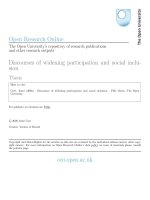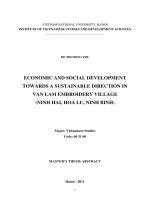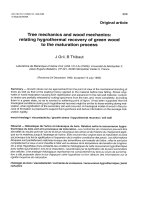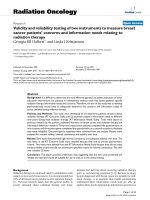CRACKED SKULLS AND SOCIAL LIABILITY: RELATING HELMET SAFETY MESSAGES TO MOTORCYCLE RIDERS
Bạn đang xem bản rút gọn của tài liệu. Xem và tải ngay bản đầy đủ của tài liệu tại đây (1.22 MB, 235 trang )
CRACKED SKULLS AND SOCIAL LIABILITY: RELATING HELMET SAFETY
MESSAGES TO MOTORCYCLE RIDERS
Susan Amy Voight
Submitted to the faculty of the University Graduate School
in partial fulfillment of the requirements
of the degree
Master of Arts
in the Department of Communication Studies,
Indiana University
August 2013
ii
Accepted by the Faculty of Indiana University, in partial
fulfillment of the requirements for the degree of Master of Arts.
Elizabeth M. Goering, Ph.D., Chair
Master’s Thesis
Committee
John Parrish-Sprowl, Ph.D.
Nancy Rhodes, Ph.D.
iii
DEDICATION
This thesis is dedicated to my late grandmother, Meta Ruthenbeck, who every day
of my young life told me, “Susie, you can do anything you want to do, if you just set your
mind to it.”
iv
ACKNOWLEDGEMENTS
I wish to acknowledge and offer my utmost appreciation to my thesis committee,
three professors who have guided me through my coursework and this thesis. Dr.
Elizabeth Goering, Dr. John Parrish-Sprowl, and Dr. Nancy Rhodes have not only helped
open my mind to the world of academic research, but also have provided extraordinary
encouragement for me, a middle-aged, late-blooming student. Dr. Parrish-Sprowl
introduced me to the many theoretical perspectives available to the communication
scholar. He empowered me by his encouragement to ignore boundaries and seek the
perspectives of all disciplines, and to recognize the value of all opinions. Dr. Elizabeth
Goering helped me to build upon my undergraduate interest in group and intercultural
communication. She has given me tools that I may take with me to future work in
academia and very importantly, in the real world. Dr. Nancy Rhodes helped me with a
difficult, yet fascinating journey to explore human communication from the perspective
of psychology and cognitive processes. Dr. Rhodes has given me the benefit of learning
that a psycho-socio perspective will add value to my previously developed socio-cultural
interest. The quality that each of these professors possess, that was so extraordinary to
me, was the ability to focus upon my individual needs. With all of the responsibilities
balanced by Dr. Goering, Dr. Parrish-Sprowl and Dr. Rhodes for undergraduate and
graduate students, when I met with them, I felt as if I were their priority. I thank each of
you because you have shown me what it means to be supportive and to foster a sense of
empowerment in every student. It is now my strongest desire to support non-traditional
students in the same positive and unwavering way that you have done for me. I am filled
with gratitude and inspiration. Thank you.
v
I am deeply grateful to the motorcycle riders who shared their time with me so
that I could learn of their culture. Some shared memories that I am sure were painful to
discuss, yet of the utmost importance to this study. I thank the eighteen riders who were
so kind as to share their experience with me. In the beginning, one rider told me that no
matter how scruffy and scary motorcycle riders might look on the outside, I would find
that they are the nicest group of people that I could ever meet. As my interviews
progressed, I surely found this to be true.
Most importantly, as in all of my life, I have had the unconditional love and
support of my family and friends. My parents have been especially supportive through
my graduate school experience. I wish to offer a special word of thanks to them. It has
been through experiencing life with these two people, part of “The Greatest Generation”,
I have come to value hard work, being open-minded, and offering a kind welcome to
people of all cultures.
Thank you to all who have helped me complete this educational journey.
vi
ABSTRACT
Susan Amy Voight
CRACKED SKULLS AND SOCIAL LIABILITY: RELATING HELMET SAFETY
MESSAGES TO MOTORCYCLE RIDERS
Grounded theory analysis, informed by a socio-cultural lens, was applied to the
narratives of eighteen motorcycle riders in order to understand, from the rider’s
perspective, receptivity to warning messages regarding motorcycle helmet use. This study
relied upon narrative analysis to identify patterns in communication that surround
motorcycle riders’ experiences. Socio-cultural cues identified importance in the process
of interest development in motorcycle riding, search for information regarding
motorcycle riding, response to danger within the motorcycle riding experience, and
attitude toward protection messages. Narratives specific to danger, or experiences of
motorcycle accidents were analyzed for comparison with fear appeal theory. Special
focus was applied to Terror Management Theory (TMT) and applied to the
communication surrounding the real experiences of motorcycle accident and the
perceived threat of danger while motorcycle riding. Communication evidencing relational
influence was examined for examples of socially constructed interpretation of social
identity and an individual rider's perspective of their lifeworld. The analysis revealed
evidence of the TMT concept of burying or denying thoughts of danger. The TMT
concept of lifeworld influence on behavior was evidenced in riders who did not accept
warning messages involving helmet use. Examples of attitude and behavior change where
present in two study participants’ narratives that described experience of severe injury
and also the death of a friend. The riders cited these occurrences as experiences that
vii
inhibited their previous behavior of placing thoughts of motorcycle injury and death in
the back of mind. Although small in number, this participant group offered multiple
categorizations of rider descriptions. The narratives offered distinction in time of life
when riding interest developed. As well, motorcycle training facilities were often noted
as a source of communication from which riders obtained influence on their future
behaviors. From this information insight was gained to offer suggestions for future
research on time of message delivery. Riders who develop interest in riding as adults
represent a category on which to focus preliminary educational messages. Individuals
who have not yet developed an interest in motorcycle riding may benefit from societal
cues that demonstrate safe riding behavior. Future research in mass media appeals
focused on motorcycle riders are suggested, as is development of educational programs
for delivery to high school audiences.
Elizabeth M. Goering, Ph.D., Chair
viii
TABLE OF CONTENTS
Chapter 1-Introduction 1
Agency Statistics on Highway Safety 1
History of Public Communication Related to Motorcycle Helmets 2
History of Motorcycle Helmet Laws in the United States 3
Rationale for Study 4
Chapter 2-Literature Review 6
Linear Model of Fear Appeal 7
Influences on Self Protection Behaviors 8
Importance of Narrative 14
Research Questions 15
Chapter 3-Methodology 17
Overview of Experiment 17
Interview Structure 19
Participant Recruitment and Data Collection 20
Sample Profile 20
Data Analysis 21
Chapter 4-Findings and Analysis 24
Self-reported Behaviors 24
Danger 25
Cognitive Processing of Warning Messages 26
Categorization of Group Characterizations 27
Relational Influences 28
ix
Societal and Cultural Influence 31
Safety 35
Specific Relational Associations on Behavior 43
Protective Behaviors 45
Media Influence 48
Chapter 5-Conclusion 51
Evidence of Theory 51
Relational Influence 56
Societal Influence 57
Response to Research Questions 57
Chapter 6-Recommendations 60
Chapter 7-Limitations 64
Appendix A: Motorcycle Rider Interview Guide 66
Appendix B: Motorcycle Rider Interview Transcripts 67
References 216
Curriculum Vitae
1
CHAPTER 1
INTRODUCTION
Agency Statistics on Highway Safety
Un-helmeted motorcycle crashes are deemed costly for riders and the public.
Traffic safety studies show that the motorcycle riding community is a population at risk
of severe and costly injury (Naumann and Shults, 2012; Insurance Institute for Highway
Safety, 2012; CDC, 2012, National Highway Transportation Safety Administration
[NHTSA], 2005, NHTSA, 2009). Statistics show that helmets provide significant
protection from traumatic brain injury upon motorcycle crash (Crompton, et al., 2012;
Cavalcante, et al., 2012; Houston, 2010; Ulmer and Northrup, 2005). On the
organization’s website, the NHTSA provided information for the year 2008, reporting
that 5,290 motorcyclists were killed. This number was an increase over 2007 statistics.
The NHTSA estimated that helmets saved the lives of 1,829 motorcyclists in 2008, and
that 823 more lives could have been saved if all motorcyclists had worn helmets
(NHTSA, 2008). These statistics suggests that more riders should be converted to being
helmet-wearing riders if fatality rates are to decline. Yet, as evidenced by the post
mortem count provided by the NHTSA, some riders choose to avoid helmet use
(NHTSA, 2008). The repercussions of motorcycle accidents go beyond pain and possible
death of the non-helmeted rider. For non-helmeted riders, emergency care is more
extensive and the time needed for physical rehabilitation is greater than for helmet riders
after a crash (Brandt, et al., 2002). Recuperation time for the accident victim may take
him or her away from work for an extended period of time, thereby creating a financial
hardship on top of medical bills. The financial consequences of non-helmeted motorcycle
2
crashes extend to all tax payers. Some studies claim that almost half of motorcyclists
admitted to hospitals have no health care insurance or they are covered by a
governmental health plan (Derrick and Faucher, 2010; Hundley, et al., 2004; Muelleman,
et al., 1992). Other studies show more favorable numbers, but confirm a gap in coverage.
For example, a 2006 Department of Transportation publication reflects insurance payer
information for motorcycle crashes that occurred between 1998 and 2002 as primarily
covered by private insurance, at 63%. Public funding, considered Medicare or Medicaid
in this report, accounted for 19.5%, with the remaining 17.5% including workers'
compensation, no-fault auto, self-pay, unknown or unreimbursed (Miller, et al., 2006).
This financial fact is why the personal freedom of the motorcycle rider overlaps with
public health interests. This raises the question, “has a public effort ever been made to
persuade motorcycle riders to wear helmets?” From the standpoint of communication,
what has taken place thus far?
History of Public Communication Related to Motorcycle Helmets
The importance of motorcycle helmet safety was recognized in the mid-20
th
century, although more geographically focused among the British population. The
relevance of helmet safety became a topic of discussions during the time of the First
World War. It has been documented that a British medic, Sir Hugh Cairns, surmised that
head injuries of courier soldiers, riding motorcycles, could be reduced with the use of a
helmet. The topic was later introduced for discussion among Britain’s civilian population
(Maartens, et al., 2002).
3
History of Motorcycle Helmet Laws in the United States
In the United States of America, individual states began to establish mandatory
helmet use laws for civilians in the 1960s. Federal influence was cited as the catalyst for
many states to enact motorcycle helmet laws in the 1970s. States without universal
helmet laws would receive less monetary funding for highways than states with universal
helmet laws. Early communication on the topic of motorcycle helmet use took place at
the government level. Laws were enacted. As a result, there was much push-back from
riders who did not wish to be subjected to helmet laws. The high-level discussions of
Federal and State entities created discourse among the individual motorcycle riders. The
riders organized. Lobbyists for motorcycle riding organizations worked to repeal the laws
in many states (Ulmer and Northrup, 2005). Since the 1970s, some states have reanalyzed
and made changes to their helmet laws. Some states changed their laws several times
(Croce, et al., 2009; NCSL.org, 2012). Data reflecting motorcycle crash (MCC) incidence
and injury, and accompanying medical treatment costs still drives the public debate on
the need for a mandatory motorcycle helmet law. For example, according to the
Insurance Institute for Highway Safety, when the state of Nebraska reinstated its
universal helmet law, acute medical hospital charges for injured motorcyclists declined
38 percent. When the state of California introduced a universal motorcycle helmet law in
1992, health care costs associated with head-injured motorcyclists declined. In California
in 1993 motorcyclist head injuries had decreased by 48% compared to 1991 rates.
4
Rationale for Study
Although it is widely accepted that motorcycle helmet use significantly reduces
the severity of MCCs (Croce, et al., 2009; IIHS, 2012; CDC, Runge, 1997), convincing
riders to wear helmets remains difficult. This may be, in part, due to the fact that within
the United States there is little evidence of public health campaigns geared toward
motorcycle helmet safety. A challenge exists to communication practitioners to develop a
persuasive health campaign focused upon motorcycle rider use of helmets. History shows
that an effort to convince lawmakers may have been the wrong place to start this
endeavor. If riders could be persuaded to choose a helmet because of a desire to protect
themselves, then perhaps laws would not be necessary.
Although academic literature contains much research on persuasive measures to
promote traffic safety (Gantz, et al., 1990; Greenfield and Kraskutas, 1993; Taubman Ben
Ari, et al., 1999; Taubman Ben Ari, 2000; Taubman Ben Ari, et al., 2000; Panic et al.,
2011), motorcycle helmet use has been is overlooked. In mainstream media, and in local
culture in the United States, it is difficult to find warning messages presented specifically
to the motorcycle riding audience. As an example of a traffic safety topic, messages
promoting responsible alcohol use cast a broad net that encompasses all vehicle
operators. Sometimes motorcycle riders will be included in this audience. These
messages become prevalent on highway billboards and television commercials around
holiday time. The ill effects of alcohol consumption are featured as encouragement for a
driver to stop and think before he or she drinks too much. To craft an effective message
geared toward motorcycle helmet use, is it likely that educating the rider on possible
traumatic outcomes will be the key to behavior change? It is necessary to ask what
5
components must be incorporated in messages to change health behaviors and, what must
be known about the audience. Communication scholars and social scientists have studied
why an individual will not adopt a protective behavior when his or her well-being is at
risk, especially after a credible source has explained the threat, and the effectiveness of
the threat-avoidance technique. Previous work that has been focused on threat messages
may guide the process of creating behavior-changing appeals to motorcycle riders.
Therefore, these bodies of literature will be reviewed in the literature review.
6
CHAPTER 2
LITERATURE REVIEW
If we are to design effective helmet-use messages, it is useful to examine previous
work that examined how fear appeals work to persuade an audience on health related
topics. The theoretical framework to be reviewed includes the early history of fear appeal
research, which reflected a drive paradigm, or fear-as-drive correlation. Work subsequent
to the drive paradigm, Protection Motivation Theory, and the more contemporary Terror
Management Theory will be reviewed. Because it is expected that fear is an emotion that
exists in relation to the context of cultural surroundings, Theory of Reasoned Action, a
theory that takes into account social context, will be discussed.
To begin, consider that when threats exist, communication messages usually
involve warnings. These threat messages are also called fear appeals. Fear appeals are
largely defined by communication scholars and social scientists as a technique for
capturing audience attention by framing the health message in the form of a threat (Janis
and Feshbach, 1953; Berkowicz and Cottingham, 1960; Leventhal, 1971; Witte, 1992).
Messages designed to imply that an undesirable outcome will occur if the viewer does not
adopt the suggested behavioral change are part of the threat, or fear appeal. However, the
psychological processes that accompany our human communication are complex. Fear is
generally regarded as a negatively valenced emotion accompanied by a level of arousal.
Fear is elicited by a threat that is perceived to be significant and personally relevant
(Easterling and Leventhal, 1989; Lang, 1984; Ortony and Turner, 1990). To a certain
extent, it is reasonable to expect that if an effective protective technique exists, most
people facing a particular threat will perform the protective measure suggested. The early
7
research demonstrated that rationale is not always used when a threat appeal message is
received. Emotional and cognitive factors create fear, anger, doubt and mistrust within
audiences, (Janis and Feshbach, 1953; Leventhal, 1970). Communication scholars and
social scientists have examined these processes for decades to determine the appropriate
structure for warning messages. In their 1953 study, psychologists Janis and Feshbach
performed an experiment on an audience using the topic of dental hygiene. Some of the
message content about diseased gums was so distasteful to the audience that some
participants in the audience rejected the message content by denying its accuracy. Some
audience members completely blocked the message from their thoughts. Overall, the
findings indicated the fear inducing messages used caused anxiety that brought about
avoidance behaviors in the participants. The participant group demonstrated various ways
of diverting audience thoughts away from the warning message and toward the
researchers who created the message. Focus on the researchers included criticism of their
honesty and personal and professional ethics. Since this early study, communication and
social science disciplines have been working to determine what amount of fear is optimal
for achieving behavior change in an audience. Although progress has been made, no good
formula has been identified for 100% effective behavior-changing persuasion within any
population.
Linear Model of Fear Appeal
Leventhal’s drive paradigm states that humans cognitively analyze fear appeal
messages, first by determining if a threat truly exists. If he or she determines that the
threat is real to them, then fear will develop (Leventhal, 1970). The early fear-as-drive
model reflected that when fear was aroused in an individual, they would take action.
8
However, subsequent research found that behavior responding to fear appeal messages
was more complex and not definitively predictable.
Influences on Self Protection Behaviors
Fear appeal research evolved to provide more complex models of the cognitive
process involved in fear appeals. Rogers introduced the Protection Motivation Theory
(PMT) to demonstrate that thought processes in reaction to threat messages are more
complex than the drive paradigm suggests (Rogers, 1985). In general, it was determined
that an initial reaction to a warning message is likely to include an analysis of the threat
to determine whether or not the individual is truly susceptible to the danger claimed. The
individual will question if the threat is upon a general population, or actually upon him or
her. If the individual determines a personal risk is likely, the person will take the next
step to analyze the proposed means of threat avoidance. The value of the proposed
avoidance mechanism is considered along with the person’s ability to perform the
avoidance behavior. For example, if an individual is warned that a home intrusion may
take place and that he or she should obtain a baseball bat for protection, the individual is
likely to make several considerations. The individual may generate the following
thoughts: Am I at risk for an intruder to come to my home? Is a baseball bat is the best
defense tool available for this incidence? Am I strong enough to lift the bat and swing
with enough force to stop an assailant? Depending upon the individual's answer to these
questions, fear may or may not arise as a result of the rear appeal message. Perhaps the
individual lives in a gated community staffed by security guards. In this case, he or she
may not feel threated. Fear likely will not develop because the individual would dismiss
the threat. Conversely, if the individual believed that the threat was imminent; fear will
9
develop and motivate the individual to consider the usefulness of a baseball bat as a
defense tool. If the individual possess confidence in the tool and his or her physical
strength to wield the bat to a damaging blow, then fear may not arise as a result of the
fear appeal message. If the individual had confidence that a bat was an effective tool for
protection and that he or she could perform the defense using the bat, then fear would
likely not arise as a result of the fear appeal message. This illustration is provided to
demonstrate that a cognitive process can have a non-linear structure. Fear subsides when
one determines that he or she is capable of managing the threat, because he or she decides
to engage in the danger avoidance behavior (Leventhal and Singer, 1966; Leventhal,
1970, 1971; Rogers and Thistlewaite, 1970; Rogers, 1975; Rogers and Deckner, 1975;
Rogers and Mewborn, 1976; Rogers, 1985; Rippentoe and Rogers, 1987; Werrij, M., et
al., 2010).
Witte’s Extended Parallel Process Model (EPPM) integrates elements of PMT,
but more closely examines the process of threat message rejection. Using the EPPM,
Witte places particular importance on the emotion of fear and the audience's means of
controlling fear. Previously used distinctions between cognitive response and emotional
response are used as a framework for EPPM. This theory takes into consideration how
perception of efficacy has the important ability to tip the audience to engage in danger
control or engage in fear control. In the scenarios when fear becomes prominent, for
example, when susceptibility is high but efficacy is low, fear becomes heightened. Then,
it is the perception of the threat that controls the intensity of the fear response. This
suggests that message acceptance or rejection can be determined by the level of
perception to both susceptibility and efficacy (Witte, 1992). EPPM seems to endorse
10
Roger’s PMT, yet expands the concept to place the primary focus on the motivating
power of fear.
However, understanding of EPPM or the protection motivation models does not
provide all the understanding needed to explain how fear appeals are processed. It gives
researchers cause to investigate emotions and other influences that may explain
acceptance or rejection of warning messages. Thoughts of vulnerability, including death
were topics included in subsequent fear appeal theory that was generated after PMT.
Influenced by the work of anthropologist Ernest Becker, social scientists
Solomon, Pysczynski and Greenberg examined mortality salience and human behavior
towards threat using Terror Management Theory (TMT) (Solomon, et al., 1991). TMT is
founded on the premise that the human animal is exclusive to all others in its
understanding of death. Humans possess an awareness of their own mortality and are
capable of forethought regarding the ramifications of their death. Yet, most people place
this thought away into their subconscious so that they may go about living. TMT is used
to examine how, when communication brings mortality back to front of mind, mortality
salience influences message processing. In this theory, one’s cultural world view, created
by omnipotent communication, and life experience, influences the acceptance or rejection
of a threat message is a facet of TMT (Taubman-Ben-Ari, et al., 1999; Taubman-Ben-
Ari, et al., 2000; Taubman-Ben-Ari 2000). TMT researchers suggested that if machismo,
or the act of living dangerously, is lauded within a cultural group, then it will be difficult
to get people to change their behavior simply by telling them that something is dangerous
(Greenberg, et al., 1986; Greenberg, et al., 1990; Greenberg, et al., 1997). An example of
this phenomenon occurred during the 1950s when then pop culture icon, actor, James
11
Dean, represented to the young people of the time, an individual with little respect for
rules. His demeanor was of a “tough guy”. Many of the youth of the time were drawn to
his performance of a rebel, and they copied his image, emulating his dress, hairstyle and
swagger. The unfortunate real life outcome for this actor is that after being stopped for
speeding and warned to drive more safely, he did not heed the officer’s warning. He died
in a car crash less than one hour after being stopped (Feaster, et al., n.d.). Did James
Dean value his rogue persona and free lifestyle more than his life?
TMT takes into account the surrounding cultural context on communication and
behaviors. TMT is a complex theory that proposes multiple mechanisms relating to
communication, emotion, and interconnected relationships with multiple aspects of one’s
world. Although there is no clear formula to define how mortality salience affects health
appeal messages, TMT may provide value to exploration of how threat appeal messages
are received by motorcycle riders. An important issue to consider is how a rider places
importance on his or her peer group. How does societal culture, and relationship, in
addition to mortality salience affect the way a motorcycle rider contemplates a warning
message to wear a helmet? More information on riders and their world view is necessary
in order to understand how safety is perceived. Is safety valued? What is it that causes
fear in motorcycle riders? Is danger valued? Can motorcycle riders be characterized into
one group, or are there many niches? These questions will help formulate the research
questions to be used for this study.
Researchers are still working to determine conditions that influence the
receptivity of the audience to warning communication. Still to be discovered is what the
right amount of fear might be, and exactly how threat is mentally processed. Whichever
12
way that fear is involved in an individual’s decision making processes, there is more to be
considered. Researchers like Fishbein and Azjen believe that The Theory of Reasoned
Action (TRA) offers one perspective of how people make decisions about their actions
and behaviors, in this case, health behaviors. TRA proposes that a person’s behavioral
intention is a function of that individual’s attitude toward the behavior, and that prior to
deciding upon one’s opinion, that person considers how the behavior would be regarded
by peers or other persons important to the individual. This is to say that the person
considers his or her reputation or self-value as it relates to the opinions of his or her peer
group. The surrounding people and their actions communicate to the individual
information on what behaviors the group values. An individual within this group will
judge his or her self-esteem based upon this information and will also make behavioral
decisions using the same processes (Fishbein, 1990; Fishbein and Ajzen, 1975).
The study of the use of fear in messaging has been examined in many different
ways and this literature review does not provide an exhaustive analysis of the topic. The
portion of literature that refers to the connection of fear-as- motivation with social world
relevance is meant, in this study, to provide structure to examine the notion of one’s
message processing based upon an understanding of his or her place within the culture.
To summarize, researchers have been able to examine a vast amount of health-
related message delivery and acceptance data in order to bring to the academic table
many theories to be tested (Janis and Feshbach, 1953; Janis and Mann, 1965; Janice,
1967; Leventhal and Singer, 1966; Leventhal 1971; Rogers, 1985; Rippentoe and Rogers,
1987; Rosenblatt, et al., 1989; Sutton, 1989; Witte, 1991; Taubman, et al., 2000). An
effective warning message, as described by Lehto and Miller (1986), must trigger a
13
multi-linear sequence of events. The warning stimulus is the message and exposure to the
message is the first step in the sequence. The last step, ideally, is when the message
recipient engages in the threat avoidance response. In a health campaign’s use of threat
appeals, there is question as to how threat should be conveyed. As demonstrated in the
Janis and Feshbach study, communication works within a human realm that is influenced
by psychological factors. Further research observed multifactorial processing of fear
messages. As communication researchers, we must ask which messages are subverted
because of cultural beliefs, personal anxieties, mood or disinterest (Cacioppo and
Berntson, 1994; Cacioppo et al., 1999; Cacioppo and Gardner, 1999; Lee and Lang,
2009; Roskos-Ewoldsen, et al., 2004; Van ‘T Riet, J., et al., 2010). These are the factors
that create interference with the message traveling to the consciousness of the recipient so
that it might be contemplated.
In order to craft an effective fear appeal message, we must learn the ideal
situation in which the intended recipient will be most receptive to a warning
communication. It appears that in the case of mass media messages, the term “public”
really means collection of many audiences. This is why the characteristics of each
audience are important to define. For example, an audience of motorcycle drivers within
the United States may be a subset of the larger group of motor vehicle drivers, those who
drive cars and trucks. However, the size, power and use of these two-wheel, motorized
vehicles provides for many subsets, suggesting that drivers of these vehicles might be a
very diverse group. Questionable is whether or not the same message to all subsets of
motorcycle riders would be useful.
14
Federal agencies offer much information about motorcycle riders. Quantitative
data gives us a clear message that deadly motorcycle accidents are exponentially more
prevalent than fatal automobile accidents. However, the Federal statistics do not get at the
real motivation of the riders. Before a persuasive message to a motorcycle rider to
encourage helmet use can be constructed, it is important to understand the worldview
beliefs of the rider and that person’s norms and attitudes that support his or her opinion of
helmet use. Fear appeal theory provides a structure to test message content and
behavioral reaction. However, to learn the rider’s decision-making processes, in-depth
probing is necessary.
Importance of Narrative
Communication theorist, Walter Fisher endorsed a theoretical concept that
humans are inherent story tellers, and that through this story-telling, reason and
rationality are expressed (Fisher, 1984). It was expected that posing open ended questions
to study participants would invite the motorcycle rider to tell his or story, one that would
reveal rationale for his or her use of safety mechanisms. To this end, it was expected that
to learn directly from the rider why he or she chooses to wear the helmet or not wear the
helmet would provide valuable information to structure more targeted communication
studies. Embracing Fisher’s shared theoretical perspective that people will reveal their
values and rationale for their behavior through the act of telling their own story,
researchers may learn how motorcycle riders frame their world. Fisher was influenced by
the ancient theory of “Rational World Paradigm” in which it is believed that humans have
the ability to rationalize in order to make decisions, that communication occurs in the
form of argument, in deliberative decision making, and that the situation or immediate
15
context, plays an important part in the deliberation. This paradigm also provides the
notion that the degree one seems rational has much to do with the decision maker’s
subject matter knowledge and argumentation skill. Rational World Paradigm assumes
that the world does fit together in a rational way, like a puzzle, and that individuals must
deliberate and decide how best to place the puzzle pieces (Fisher, 1984; Dahlstrom,
2010).
Groups make poor decisions. Examples are documented on the evening news,
almost daily. Narratives represent a powerful and ubiquitous form of communication that
influence what individuals believe about the world (Dahlstrom, 2010). In this study, the
power of narrative was regarded as an effective means to gaining general understanding
of motorcycle riders and their safety motivations. Specifically in question is the behavior
riders employ in order to make a decision about helmet use. Can patterns of influence be
recognized so that intervention, or pattern change, might be suggested to achieve a higher
incidence of helmet use? What messages might the rider be consuming, and from what
source, is the rider using to analyze his or her behavior toward helmet use? What cultural,
societal or relational factors might affect the riders' decision? This study is meant to be
broad and exploratory; the following research questions are designed to illuminate future
patterns of behavior to study.
Research Questions
Two research questions pertain to this study.
Research Question 1: From the rider’s perspective, what are the cultural or social
cues and common ideas that affect a rider’s decision to wear a helmet?
16
Research Question 2: Under what conditions will a motorcycle rider be most
likely to recognize a personal vulnerability to a threat contained in a fear appeal
message and devote deliberate effort to evaluating the avoidance behavior
suggested in the message?









